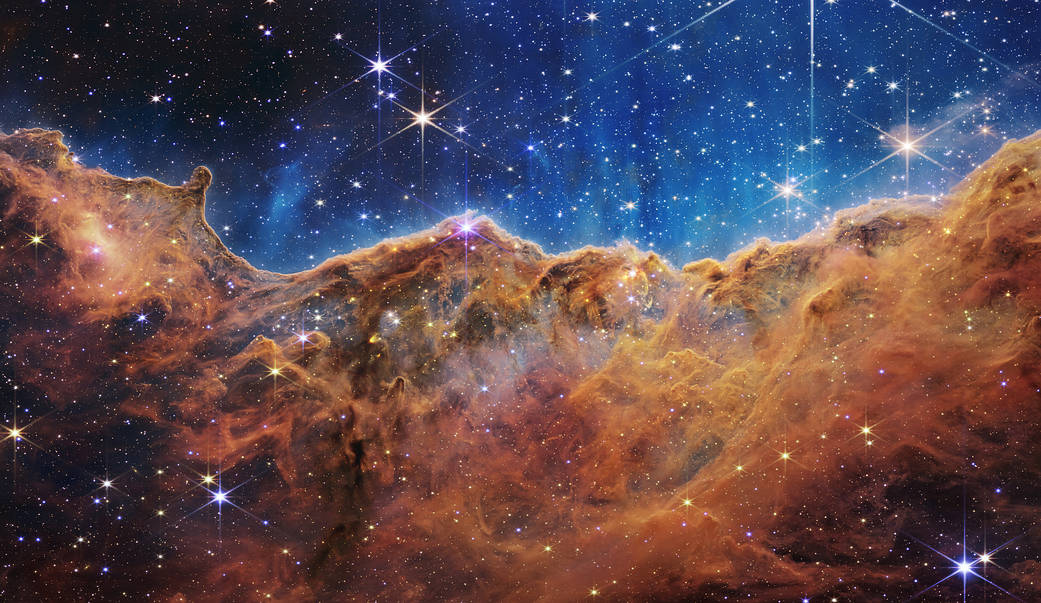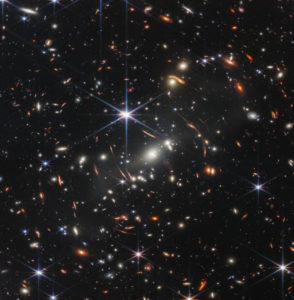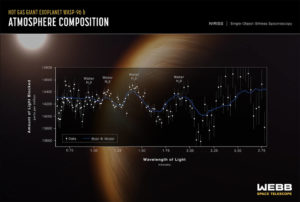An Astrophysicist’s First Look at JWST Images
August 2, 2022
The first images from NASA’s newest space telescope, the James Webb Space Telescope (JWST), presented the world with images of the cosmos never seen before, including the deepest and sharpest infrared image of the distant universe ever produced. “This is such an exciting moment for astronomy,” says Harvey Mudd College astrophysics professor Daniel Tamayo. “It’s hard to believe that JWST has been over 30 years in the making, and these gorgeous images really are a testament to the enormous efforts of a huge team of scientists and engineers to overcome some remarkable technical challenges.” Here, Tamayo gives some context to the images and comments on the significance of the JWST project.
What was your reaction to seeing the first JWST images?
Awe. Only about a dozen of the objects in their deep field is a star in our own galaxy. Stars in our own galaxy are so close and so bright that we see the faint light diffracted by the telescope as six radial spikes around each of them.
Yet, there are a few hundred billion stars in our own galaxy, so we really are looking at a tiny patch of the sky. In fact, we are looking at a patch of the universe the size of a grain of sand held out in front of you at arm’s length.

What else is in this image?
Each of those other objects (the ones without spikes) is another galaxy, each of which likely has about 100 billion stars (or more!) like our own Milky Way. It’s hard to imagine an image to better capture what a small place we occupy in the cosmos, yet, at the same time, honor our backwoods species’ efforts to peer into the darkest depths of our universe to find our place within it.
How do these images compare to images from JWST’s predecessor, the Hubble Space Telescope (HST)?
This image field was chosen in part because HST had already imaged it. Part of the reason for the sharper and brighter JWST image is the new telescope is larger. But far more interesting is another reason.
Galaxies are bright at the visible wavelengths at which their constituent stars emit most strongly. However, the fact that the universe is expanding causes light from distant galaxies to be stretched toward longer wavelengths. This pushes light emitted at visible wavelengths (where HST focused) from distant galaxies to be received at longer infrared wavelengths (which JWST is designed to capture). That’s why so much effort has gone into developing a large, infrared space telescope. It lets you go after the most distant galaxies in our observable universe. While HST had to stare at the same patch of sky for weeks to obtain a worse version of the above image, the brighter JWST image only required 12 hours.
And it’s not just a contest to see how far we can look. The further we look into space, the farther back we see in time. The closest star to us (Proxima Centauri) is four light years away. That means that, given the fast but finite speed of light, Proxima Centauri is so far away that it takes any light it emits four years to reach us. That implies that when we see that star system, we aren’t seeing it the way it is today, rather, we are seeing it the way it was four years ago. Clearly, this effect gets worse the farther away the object is. Our most powerful telescopes therefore not only allow us to see farther away in space, they let us see farther away in time.
Just how far back are we seeing?
If Jan. 1 represented the start of the universe at the Big Bang, and today represented Dec. 31, this JWST image is revealing to us galaxies going all the way back to the second week of January. One of the great promises of JWST is that it will allow us to study how some of the first galaxies formed in the universe.
What do you find most fascinating about the JWST project?

A funny side effect of JWST’s 30-year development is that it was conceived when the only planets we knew of were the ones in our own solar system. However, since then, we have gone on to discover over 5,000 planets (and rising!) around other stars. And, it turns out that infrared wavelengths are very interesting for studying planetary atmospheres.
Different chemical compounds absorb light at specific wavelengths, so looking for these signature absorptions allows us to diagnose the composition of planetary atmospheres. Many of these signature absorptions for important compounds like water and methane are at infrared wavelengths. So JWST provides a really exciting opportunity to characterize the atmospheres of so-called exoplanets. Planets are so tiny compared to their host star, so doing this is remarkably tough, but a lot of effort has gone into adapting JWST’s scientific instruments to handle this task. Recently scientists revealed the first such effort on WASP-96b, an exoplanet intermediate between Jupiter and Saturn.
Such data is presented as a spectrum. We are seeing how much starlight the planet is blocking (y-axis) at many different wavelengths in the infrared (x-axis). The results (white points) show peaks in how much starlight the planet is absorbing at four specific wavelengths water vapor absorbs (labeled Water H20). This definitive detection of water vapor in WASP-96b’s atmosphere is an exciting preview of what is to come. As a census of atmospheric compositions is obtained, this will provide clues into typical formation conditions.
Giant gas planets like WASP-96b will be the workhorse targets that JWST will be able to characterize efficiently. It would, of course, be even more exciting to look for water vapor in terrestrial planets’ atmospheres, which may belie the existence of oceans and the possibility for alien life. Observations of these much-smaller planets is much more challenging, but JWST will go after the most favorable targets. Without a doubt, the most exciting target is the TRAPPIST-1 system, a tiny star—one of the 300 closest to us—which has been discovered to host seven Earth-sized planets. Several of these may be at the right distance from their star to host liquid water, and JWST plans to characterize each of their atmospheres.
How do JWST findings enhance your HMC research?
The JWST project is somewhat removed from my own research, but I still find it fascinating. My work is focused on understanding the formation of planetary systems. It is clear that many planetary systems, including our own, have quite violent histories, involving past planetary collisions and dramatic orbital rearrangements. I am working to understand how this dynamical chaos arises in these planetary systems to give rise to such collisions. I am excited to work with Harvey Mudd’s amazing undergraduates to elucidate typical formation histories for planetary systems, including our own. This is particularly interesting in the case of TRAPPIST-1 (learn more via this explainer video, created in collaboration with Thought Café).
